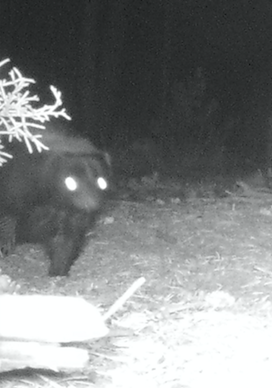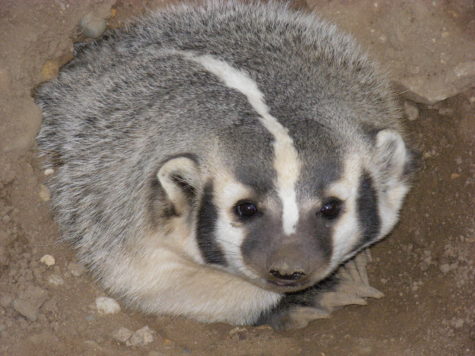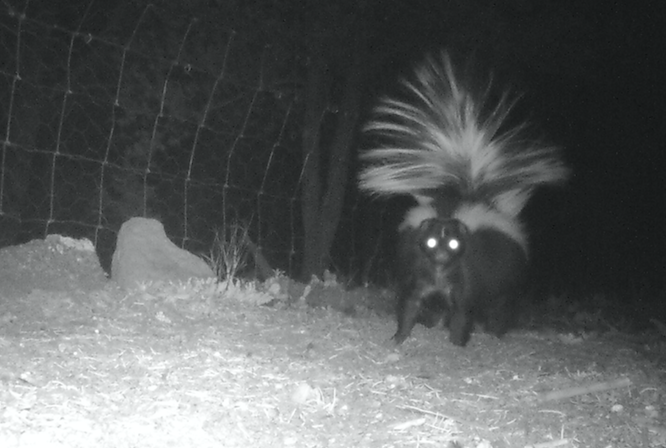![]() Sorting through photos from our motion-triggered game camera reminds me a lot of field work. For every target animal you’re seeking, you end up looking at a lot of deer. So when I recently discovered a creature that I couldn’t immediately identify in our roll of game cam photos, I was thrilled.
Sorting through photos from our motion-triggered game camera reminds me a lot of field work. For every target animal you’re seeking, you end up looking at a lot of deer. So when I recently discovered a creature that I couldn’t immediately identify in our roll of game cam photos, I was thrilled.
It looked wide and strong, and for a split second I wondered if it could be a bear. But the size easily ruled that out — it was too small and squat.
Immediately, my mind went to the most exotic, exciting possibility — wolverine!
According to my National Audubon Society Field Guide to the Rocky Mountain States, the wolverine, or Gulo gulo, is “robust,” “bear-like” and “very strong and fearless for its size; drives bears from kill.” Its range includes western Colorado and its habitat is listed as forests, scrub and meadows, which pretty much describes the back acres of our farm where our game cam spotted the mystery creature. The wolverine’s lateral stripes “can range from extremely prominent to almost indiscernible,” according to the Wolverine Foundation.
By the time I downloaded the photo, there were no tracks left, so all I had to go on was the photo. Checking the photo with the species accounts, everything seemed to check out. Of course, it was just one datum, so I called in some backup.
I sent the photo to some wildlife savvy friends, and they were split. A lot of them agreed it could be a wolverine. A few others wondered if it were a badger.
The American badger, Taxidea taxus, also fit the description pretty well. The range, habitat and body shape — “wide, flattish,” according to the Audubon guide — all fit. While it’s not clear that there are any wolverines left in Colorado, badgers are pretty common in the state, which tilted the scales in its favor.
I’ll be honest, I wanted it to be wolverine. Well, sort of. They’re vicious killers so maybe I didn’t want them hanging around my chickens, cats and other animals. I didn’t really want a badger around either. Still, there’s something thrilling about the thought of a dangerous wild animal inhabiting a shared space.
After looking at a bunch of photos in my field guides and online, I decided it was probably a badger.
And then I downloaded the latest photos, the first of which were taken the day (night, really) after the mystery photo was shot. And here’s what I found.
Skunk! It was a skunk. As soon as I saw this photo (and a video of what was probably the same skunk the following night) I was convinced.
Why? Because until I had seen the second photo and video, I had very little hard evidence to go on. The notion that the animal was a wolverine or badger was based almost entirely on what could be seen on the photo. And really, that wasn’t much. In the age of the internet, we all know how deceptive photos can be.
Wild animals can be hard to identify on the fly (or run or in a single snapshot of a camera) and so it’s important to consider a principle called “base rate neglect” or the “base rate fallacy.” It’s the tendency to favor the most recent or individual information while ignoring the prior probability of a particular outcome. In this case, it was taking the bodily characteristics of an animal in a night photo as the most compelling evidence, without giving as much consideration to the probability that a wolverine would be lurking in my forest. It wasn’t impossible that it was a wolverine, but chances were much greater that it was not. Badgers are more common around here than wolverines, and skunks are even more widespread still. I also had lots of prior evidence that there were skunks around — I’d chased one out of my garden shed multiple times.
The base rate principle is useful for birding too. Hawks are notoriously difficult to identify when they’re high in the air. We have lots of them around here, and I usually look up and say, “Look, a red-tailed hawk!” Because chances are, I’ll be correct.
Wolverine image: Max Pixel. Badger by Jonathunder


Badgers dig impressive holes into their dens. I really did think it was a badger!
Occam’s Razor?
Occam’s razor indeed! Dea, I was sure it was a badger too… until I wasn’t.